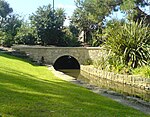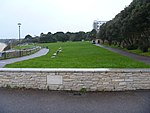Poole Bay

Poole Bay is a bay in the English Channel, on the coast of Dorset in southern England, which stretches 16 km from Sandbanks at the mouth of Poole Harbour in the west, to Hengistbury Head in the east. Poole Bay is a relatively shallow embayment and consists of steep sandstone cliffs and several 'chines' that allow easy access to the sandy beaches below. The coast along the bay is continuously built up, and is part of the South East Dorset conurbation, including parts of the towns of Poole, Bournemouth and Christchurch. The bay is sometimes referred to as Bournemouth Bay, because much of it is occupied by Bournemouth. In terms of sand on England's south coast the bay presents the longest stretch; much exceeded by the total to the west across numerous bays and coves but greater than the three such stretches to the east, Avon Beach, West Wittering and Camber Sands.
Excerpt from the Wikipedia article Poole Bay (License: CC BY-SA 3.0, Authors, Images).Poole Bay
Westover Steps,
Geographical coordinates (GPS) Address Nearby Places Show on map
Geographical coordinates (GPS)
| Latitude | Longitude |
|---|---|
| N 50.666666666667 ° | E -1.8666666666667 ° |
Address
WYTCHFARMM15(M2redrill)
Westover Steps
BH2 5BE , West Cliff
England, United Kingdom
Open on Google Maps









